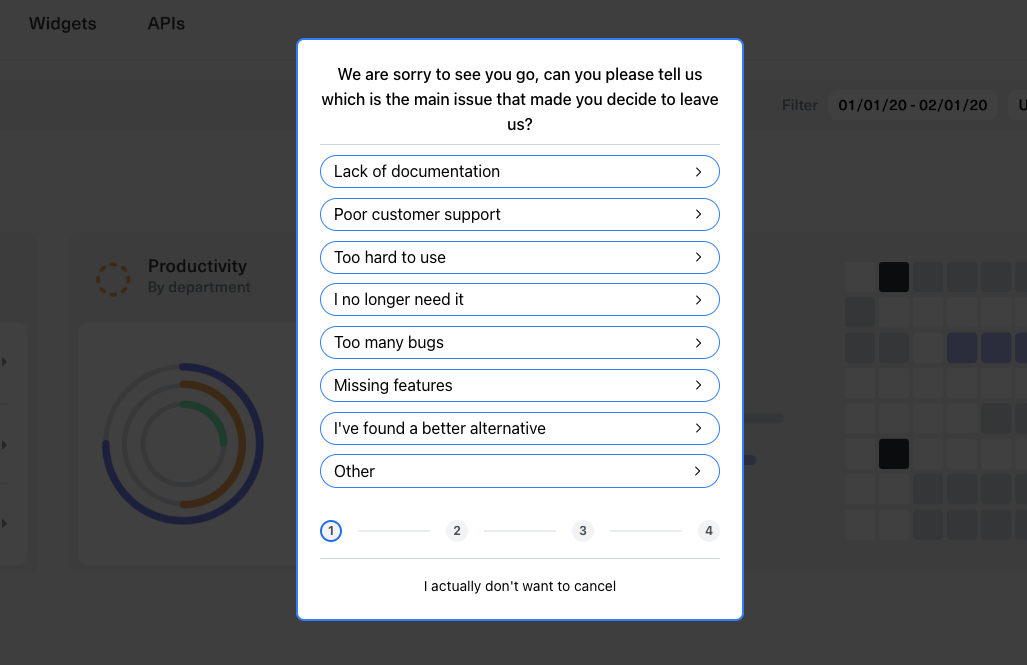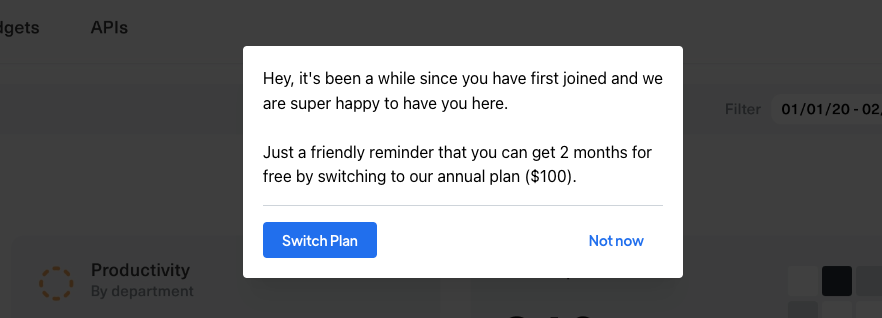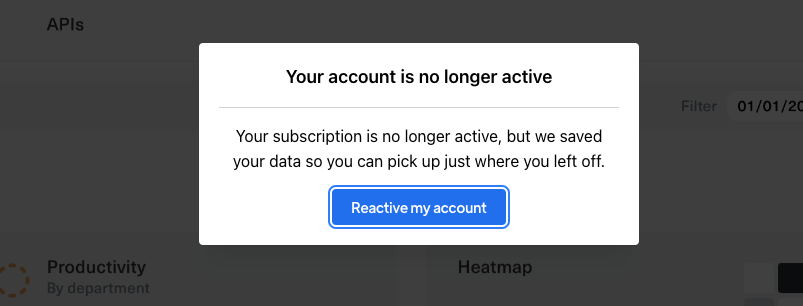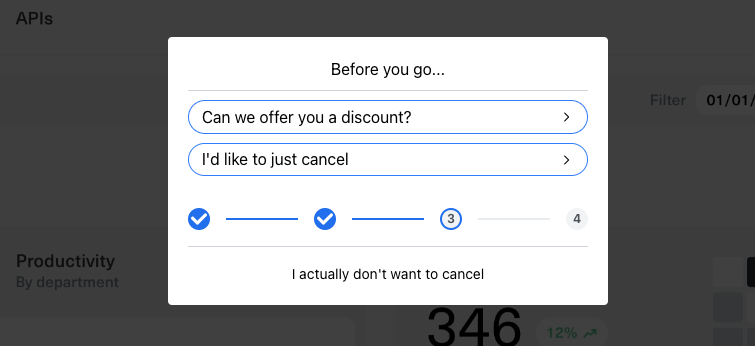How to reduce churn: advice from your fellow indie hackers
In my last post, I asked everyone to share their best churn tips. Here I've cleaned up all the feedback and compiled a list from all the suggestions, enjoy!
Table of contents
- Find out why your users are churning
- Act on the main reason why your users are churning
- Win-back lost customers
- “Cheat” your churn rate
- Address your involuntary churn
- Prevent churn from happening
- Adding targeted offers to your flow
Find out why your users are churning
How do you fix a problem without knowing what the problem is? You don't, it's impossible... You know that you have churn problem, but what kind of churn? WHY are your users churning? What type of churn is it? Active? Involuntary? Maybe it's an issue with your activation or your value proposition?
For starters, you have to identify the type of churn is affecting your business. In all likelihood, it will probably be a combination of various types, but we need to find out for certain.
Fortunately, it's rather easy to do. When a customer is going to cancel their subscription, instead of only asking for the confirmation or redirecting them to your payment provider page, gather some feedback with for their reason.
Something along the line of:
We are sorry to see you go, can you please tell us the reason why you are leaving?
The options should be related to your specific product and should be around areas that you think might be pain points for the user or where you think you might be losing them. You don't want to burden them or over complicate things, it's important to remember...they're churning, let's not push too many buttons!
Try to keep the potential reasons to 5-7 options. Here are some examples:
- Couldn't figure out how to use the product
- Poor customer support experience
- Missing features
💡 DON’T put “Too expensive” as an answer. First of all, they have already paid for it so it wasn’t expensive in the first place, but if they are churning, of course they think it is too expensive, because if they paid 1 cent per year they wouldn’t even have bothered to churn. Adding “Too expensive” as an option just gives you zero insight.
Act on the main reason why your users are churning
Now that you are collecting feedback on why your users are churning, we can start analyzing those insights and act upon them. This is when the options that you made available to your users will matter, since each answer will need to be linked to an area where we can act on (this is another reason why we didn’t put “Too expensive” on the possible answers).
From our example this is how we would tie the responses to an area where we can act on:
- Don’t know how to use it → Onboarding
- Poor customer support → Customer support/Documentation
- Missing features → Product
Now rank the areas based on the one that received the most responses and let’s see how we can act on them.
Don’t know how to use it
This is clearly a problem with the onboarding. If you users don’t know how to use your product or find it confusing or the time-to-value is too long, then you need to make a better job at onboarding them and showcasing your best features and how they can solve the problem that you promised of solving.
Add a nice step-based onboarding flow, add some tooltips that guide the user or even just adding some documentation and blog articles might help your users (but remember that people don’t like to read 😉).
Poor customer support
Just get good. I mean, there isn’t a lot to say here. You need to check in on your customers and especially answer them fast when they reach out to you. I know it is annoying and I know that some people are dumb, but you still have to do it.
One thing that might help is installing a live chat widget on your website, if you don’t want to be fancy with Intercom, then a free alternative like Tawk.to will get the job done as well. Besides that, people are much more prone to give feedback and point out flaws or bugs in your app if there is a quick chat bubble where they can write them to, instead of having to open their email client.
Missing features
This is could be an issue with your product OR an issue with your messaging... if someone signs up for your service and expects A but in reality you do B, your messaging and marketing probably needs some work.
Regardless, you're going to need more context from these churned users...you need to know which feature or integration the user was expecting that you didn't deliver. You're likely going to want to follow up with these customers manually or better yet try to get them on a 10 minute Zoom call to tease out what might have been missing.
Building every feature requested under the sun is a cardinal sin tech founders too often commit. I know it may be tempting...if you're a technical founder like me, building features is what we do best, but it can often be a time-suck.
Play it safe here, gather more context from these users and wait until you hear and see multiple requests from users BEFORE building that new integration 😉.
Win-back lost customers
Now that we know why the users are churning and we are fixing those issues, we can start to win-back lost customers that have churned in the past. This is as easy as sending them a nice personalized email mentioning the reason why they left and how you have addressed it.
We recommend to send an email and then a followup with a discount code just for them (20-30% should be the right amount).
“Cheat” your churn rate
Another amazing way of improving your churn-rate without directly addressing it (like we did before and how you are still doing to this point) is to upgrade monthly plans to annual plans.
Besides the nice cash injection upfront, annual users are much more less likely to churn. This is due to an higher investment in the product and also to the fact that as a minimum, they will stay for 12 months.
I know this isn’t exactly reducing churn how you were imagining it, but it is actually very effective and used widely as a strategy to reduce churn and boost customer lifetime value (LTV).
Address your involuntary churn
And now the scary part. Did you know that on average 40% of your churn is involuntary? What we have tackled until now is voluntary churn, which means a user logging in your app and deciding to cancel his subscription. Involuntary churn is all the churn that happens off-platform like credit-card failures.
Luckily payment providers like Stripe are getting better and better at handling these issues (although by default they are not enabled?!?!), but you still have to address them in your app.
Showing a simple banner when the last payment of a user has failed with a link to change his billing info is more than enough in most cases and if that doesn’t work, locking him out of the app is a must!
Prevent churn from happening
"Prevention is better than cure" and this applies to your churn rate too. If your clients are happy and engaged with the product then they will not churn. Having churn indicators that flag customers that are likely to churn (maybe by looking at their engagement history or by looking at the number of recent sign-ins) will give you an handy list of people that need to be contacted. You can then ask those people how they need help and how you can help them get the most value out of your product.
Adding targeted offers to your flow
Once you have done all the previous steps and you have enough data, you can start automating the salvage process of a user that is actively churning. This means that after you ask for the reason why he is churning, you also make an offer based on his answer to try and make him stay. With good enough data, this will greatly improve churn rate!
Wrapping it up
We truly hope this is going to help you reduce your churn and improve your business and if this sounds like a lot, it is!
Shameless plug
My team and I had to build something like this for our first business and we spent a lot of time on it, especially in making it useful and not just throwing something together. We found it so useful that we decided to extract the functionality that we had built into a standalone product that everyone can use for FREE.
If you think we can help, please 👉 check it out.






Great post and definitely going to follow some tips.
Great post and I remember there was another product by an indiehacker I think it was like https://churnkey.co/ - and I wonder - how actually "effective" are these SaaS companies are reducing churn?
I would love to hear from actual users of these anti-churn solutions what % of churns they can actually recover, return whatever
We are actually building in the same space!
We had built an in-house tool to manage our churn and decided to package it into a product and since we used it on our own SaaS, I can guarantee it works!
P.S. it's called LlamaFi (https://www.llamafinancial.com/)
Great post, Your actionable steps for reducing churn are clear and practical. I'm looking forward to applying these insights. Thanks for sharing!
Great post, i would like to introduce myself to the community Hey, my name is Amogh & i Just Launched echonow(dot)co, A powerful browser extension that Effortlessly allows you to leave voice comments on popular platforms like Google Suite, Notion, Miro, Jira, and many more with real-time transcription.
I am looking for early adopters & feedback on the MVP. ( I don't mind roasts ) 'm super excited for the new year with a goal to achieve $1000MRR in the next three months.
very valuable -- thank you!